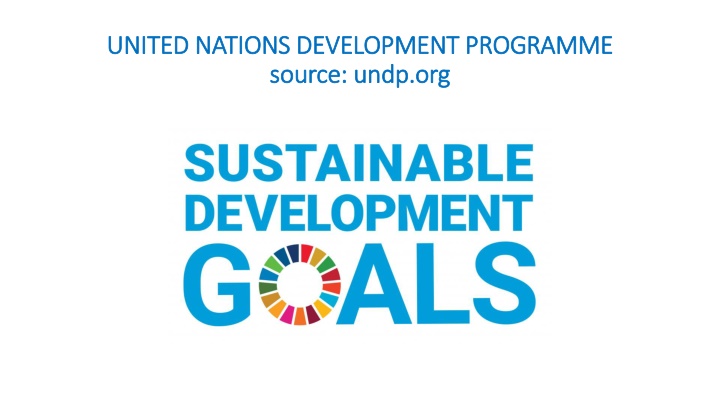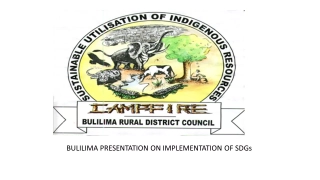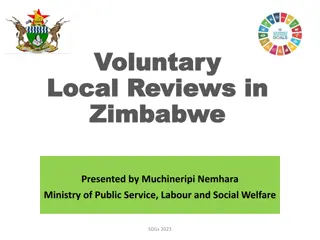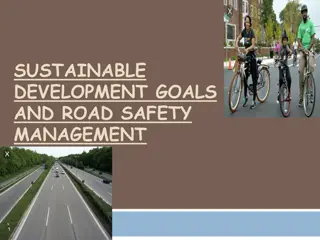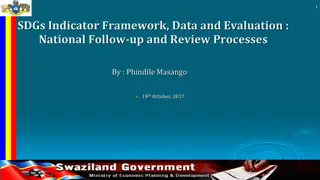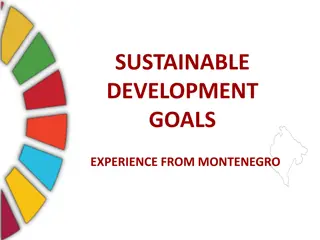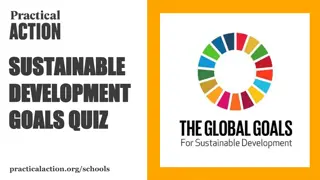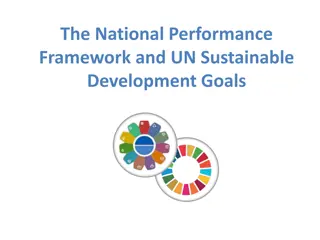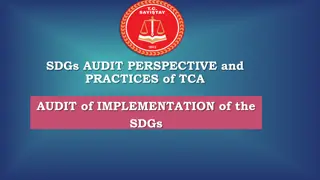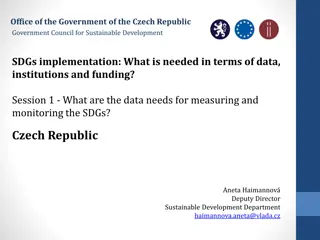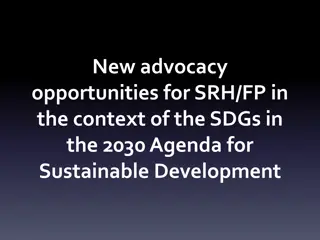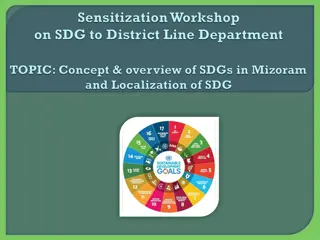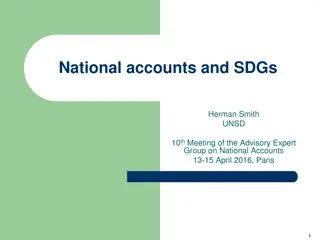United Nations Sustainable Development Goals (SDGs) Overview
The United Nations Sustainable Development Goals (SDGs), also known as the Global Goals, aim to end poverty, hunger, and various inequalities by 2030. There are 17 interconnected SDGs covering key aspects like poverty eradication, gender equality, climate action, and sustainable development. These goals require collaborative efforts from all sectors of society to achieve significant positive impacts globally.
Download Presentation

Please find below an Image/Link to download the presentation.
The content on the website is provided AS IS for your information and personal use only. It may not be sold, licensed, or shared on other websites without obtaining consent from the author.If you encounter any issues during the download, it is possible that the publisher has removed the file from their server.
You are allowed to download the files provided on this website for personal or commercial use, subject to the condition that they are used lawfully. All files are the property of their respective owners.
The content on the website is provided AS IS for your information and personal use only. It may not be sold, licensed, or shared on other websites without obtaining consent from the author.
E N D
Presentation Transcript
UNITED NATIONS DEVELOPMENT PROGRAMME UNITED NATIONS DEVELOPMENT PROGRAMME source: source: undp.org undp.org
Sustainable Development Goals Sustainable Development Goals Facts & Figures Facts & Figures United Nations Development Programme
The Sustainable Development Goals (SDGs), also known as the Global Goals, were adopted by all United Nations Member States in 2015 as a universal call to action to end poverty, protect the planet and ensure that all people enjoy peace and prosperity by 2030. The 17 SDGs are integrated that is, they recognize that action in one area will affect outcomes in others, and that development must balance social, economic and environmental sustainability. Through the pledge to Leave No One Behind, countries have committed to fast-track progress for those furthest behind first. That is why the SDGs are designed to bring the world to several life-changing zeros , including zero poverty, hunger, AIDS and discrimination against women and girls. Everyone is needed to reach these ambitious targets. The creativity, knowhow, technology and financial resources from all of society is necessary to achieve the SDGs in every context. What are the What are the Sustainable Sustainable Development Development Goals? Goals? https:// https://www.undp. www.undp. org org/content/ /content/undp en en/home/sustaina /home/sustaina ble ble- -development development- - goals.html goals.html undp/ /
Goal 1. End poverty in all its forms everywhere Goal 2. End hunger, achieve food security and improved nutrition and promote sustainable agriculture Goal 3. Ensure healthy lives and promote well- being for all at all ages Goal 4. Ensure inclusive and equitable quality education and promote lifelong learning opportunities for all Goal 5. Achieve gender equality and empower all women and girls Goal 6. Ensure availability and sustainable management of water and sanitation for all 17 Goals https://sustain abledevelopme nt.un.org/post 2015/transfor mingourworld
Goal 7. Ensure access to affordable, reliable, sustainable and modern energy for all Goal 8. Promote sustained, inclusive and sustainable economic growth, full and productive employment and decent work for all Goal 9. Build resilient infrastructure, promote inclusive and sustainable industrialization and foster innovation Goal 10. Reduce inequality within and among countries Goal 11. Make cities and human settlements inclusive, safe, resilient and sustainable Goal 12. Ensure sustainable consumption and production patterns 17 Goals https://sustaina bledevelopmen t.un.org/post20 15/transformin gourworld
Goal 13. Take urgent action to combat climate change and its impacts Goal 14. Conserve and sustainably use the oceans, seas and marine resources for sustainable development Goal 15. Protect, restore and promote sustainable use of terrestrial ecosystems, sustainably manage forests, combat desertification, and halt and reverse land degradation and halt biodiversity loss Goal 16. Promote peaceful and inclusive societies for sustainable development, provide access to justice for all and build effective, accountable and inclusive institutions at all levels Goal 17. Strengthen the means of implementation and revitalize the global partnership for sustainable development 17 Goals https://sustain abledevelopme nt.un.org/post 2015/transfor mingourworld
736 million people still are in extreme poverty. 10 percent of the world s population live in extreme poverty, down from 36 percent in 1990. Some 1.3 billion people live in multidimensional poverty. Half of all people living in poverty are under 18. One person in every 10 is extremely poor. 80 percent of people living on less than $1.90 are in South Asia and sub-Saharan Africa. 1. No Poverty 1. No Poverty https://www.und p.org/content/un dp/en/home/sus tainable- development- goals/goal-1-no- poverty.html
The number of undernourished people reached 821 million in 2017. In 2017 Asia accounted for nearly two thirds, 63 percent, of the world s hungry. Nearly 151 million children under five, 22 percent, were still stunted in 2017. More than 1 in 8 adults is obese. 1 in 3 women of reproductive age is anemic. 26 percent of workers are employed in agriculture. 2. Zero Hunger 2. Zero Hunger https://www.und p.org/content/un dp/en/home/sus tainable- development- goals/goal-2- zero-hunger.html
At least 400 million people have no basic healthcare, and 40 percent lack social protection. More than 1.6 billion people live in fragile settings where protracted crises, combined with weak national capacity to deliver basic health services, present a significant challenge to global health. By the end of 2017, 21.7 million people living with HIV were receiving antiretroviral therapy. Yet more than 15 million people are still waiting for treatment. Every 2 seconds someone aged 30 to 70 years dies prematurely from noncommunicable diseases - cardiovascular disease, chronic respiratory disease, diabetes or cancer. 7 million people die every year from exposure to fine particles in polluted air. More than one of every three women have experienced either physical or sexual violence at some point in their life resulting in both short- and long-term consequences for their physical, mental, and sexual and reproductive health. 3. Good Health and 3. Good Health and Well Well- -Being Being https://www.undp. org/content/undp/ en/home/sustaina ble-development- goals/goal-3-good- health-and-well- being.html
Enrollment in primary education in developing countries has reached 91 percent. Still, 57 million primary-aged children remain out of school, more than half of them in sub-Saharan Africa. In developing countries, one in four girls is not in school. About half of all out-of-school children of primary school age live in conflict-affected areas. 103 million youth worldwide lack basic literacy skills, and more than 60 percent of them are women. 6 out of 10 children and adolescents are not achieving a minimum level of proficiency in reading and math. 4. Quality 4. Quality Education Education https://www.undp. org/content/undp/ en/home/sustaina ble-development- goals/goal-4- quality- education.html
Women earn only 77 cents for every dollar that men get for the same work. 35 percent of women have experienced physical and/or sexual violence. Women represent just 13 percent of agricultural landholders. Almost 750 million women and girls alive today were married before their 18th birthday. Two thirds of developing countries have achieved gender parity in primary education. Only 24 percent of national parliamentarians were women as of November 2018, a small increase from 11.3 percent in 1995. 5. Gender Equality https://www.undp. org/content/undp/ en/home/sustaina ble-development- goals/goal-5- gender- equality.html
71 percent of the global population, 5.2 billion people, had safely-managed drinking water in 2015, but 844 million people still lacked even basic drinking water. 39 percent of the global population, 2.9 billion people, had safe sanitation in 2015, but 2.3 billion people still lacked basic sanitation. 892 million people practiced open defecation. 80 percent of wastewater goes into waterways without adequate treatment. Water stress affects more than 2 billion people, with this figure projected to increase. 80 percent of countries have laid the foundations for integrated water resources management. The world has lost 70 percent of its natural wetlands over the last century. 6. Clean Water and Sanitation https://www.undp. org/content/undp/ en/home/sustaina ble-development- goals/goal-6-clean- water-and- sanitation.html
One in 7 people still lacks electricity, and most of them live in rural areas of the developing world. Energy is the main contributor to climate change, it produces around 60 percent of greenhouse gases. More efficient energy standards could reduce building and industry electricity consumption by 14 percent. More than 40 percent of the world s population 3 billion rely on polluting and unhealthy fuels for cooking. As of 2015, more than 20 percent of power was generated through renewable sources. The renewable energy sector employed a record 10.3 million people in 2017. 7.Affordable and Clean Energy https://www.undp. org/content/undp/ en/home/sustaina ble-development- goals/goal-7- affordable-and- clean-energy.html
An estimated 172 million people worldwide were without work in 2018 - an unemployment rate of 5 percent. As a result of an expanding labor force, the number of unemployed is projected to increase by 1 million every year and reach 174 million by 2020. Some 700 million workers lived in extreme or moderate poverty in 2018, with less than US$3.20 per day. Women s participation in the labor force stood at 48 per cent in 2018, compared with 75 percent for men. Around 3 in 5 of the 3.5 billion people in the labor force in 2018 were men. Overall, 2 billion workers were in informal employment in 2016, accounting for 61 per cent of the world s workforce. Many more women than men are underutilized in the labor force 85 million compared to 55 million. 8. Decent Work and Economic Growth https://www.undp.o rg/content/undp/en/ home/sustainable- development- goals/goal-8-decent- work-and-economic- growth.html
Worldwide, 2.3 billion people lack access to basic sanitation. In some low-income African countries, infrastructure constraints cut businesses productivity by around 40 percent. 2.6 billion people in developing countries do not have access to constant electricity. More than 4 billion people still do not have access to the Internet; 90 percent of them are in the developing world. The renewable energy sectors currently employ more than 2.3 million people; the number could reach 20 million by 2030. In developing countries, barely 30 percent of agricultural products undergo industrial processing, compared to 98 percent high-income countries. 9. https://www.undp.org/c ontent/undp/en/home/ sustainable- development- goals/goal-9-industry- innovation-and- infrastructure.htmlIndus try, Innovation, and Infrastructure
In 2016, 22 percent of global income was received by the top 1 percent compared with 10 percent of income for the bottom 50 percent. In 1980, the top one percent had 16 percent of global income. The bottom 50 percent had 8 percent of income. Economic inequality is largely driven by the unequal ownership of capital. Since 1980, very large transfers of public to private wealth occurred in nearly all countries. The global wealth share of the top 1 percent was 33 percent in 2016. Under "business as usual", the top 1 percent global wealth will reach 39 percent by 2050. Women spend, on average, twice as much time on unpaid housework as men. Women have as much access to financial services as men in just 60 percent of the countries assessed and to land ownership in just 42 percent of the countries assessed. 10. Reduced Inequality https://www.undp. org/content/undp/ en/home/sustaina ble-development- goals/goal-10- reduced- inequalities.html
In 2018, 4.2 billion people, 55 percent of the worlds population, lived in cities. By 2050, the urban population is expected to reach 6.5 billion. Cities occupy just 3 percent of the Earth s land but account for 60 to 80 percent of energy consumption and at least 70 percent of carbon emissions. 828 million people are estimated to live in slums, and the number is rising. In 1990, there were 10 cities with 10 million people or more; by 2014, the number of mega-cities rose to 28, and was expected to reach 33 by 2018. In the future, 9 out of 10 mega-cities will be in the developing world. In the coming decades, 90 percent of urban expansion will be in the developing world. The economic role of cities is significant. They generate about 80 percent of the global GDP. 11. Sustainable Cities and Communities https://www.undp.o rg/content/undp/en/ home/sustainable- development- goals/goal-11- sustainable-cities- and- communities.html
1.3 billion tonnes of food is wasted every year, while almost 2 billion people go hungry or undernourished. The food sector accounts for around 22 percent of total greenhouse gas emissions, largely from the conversion of forests into farmland. Globally, 2 billion people are overweight or obese. Only 3 percent of the world s water is fresh (drinkable), and humans are using it faster than nature can replenish it. If people everywhere switched to energy efficient lightbulbs, the world would save US$120 billion annually. One-fifth of the world s final energy consumption in 2013 was from renewable sources. 12. Responsible Consumption and Production https://www.undp.o rg/content/undp/en/ home/sustainable- development- goals/goal-12- responsible- consumption-and- production.html
As of 2017 humans are estimated to have caused approximately 1.0 C of global warming above pre-industrial levels. Sea levels have risen by about 20 cm (8 inches) since 1880 and are projected to rise another 30 122 cm (1 to 4 feet) by 2100. To limit warming to 1.5C, global net CO2 emissions must drop by 45% between 2010 and 2030, and reach net zero around 2050. Climate pledges under The Paris Agreement cover only one third of the emissions reductions needed to keep the world below 2 C. Bold climate action could trigger at least US$26 trillion in economic benefits by 2030. The energy sector alone will create around 18 million more jobs by 2030, focused specifically on sustainable energy. 13. Climate Action https://www.undp. org/content/undp/ en/home/sustaina ble-development- goals/goal-13- climate- action.html
The ocean covers three quarters of the Earths surface and represents 99 percent of the living space on the planet by volume. The ocean contains nearly 200,000 identified species, but actual numbers may lie in the millions. As much as 40 percent of the ocean is heavily affected by pollution, depleted fisheries, loss of coastal habitats and other human activities. The ocean absorbs about 30 percent of carbon dioxide produced by humans, buffering the impacts of global warming. More than 3 billion people depend on marine and coastal biodiversity for their livelihoods. The market value of marine and coastal resources and industries is estimated at US$3 trillion per year, about 5 percent of global GDP. 14. Life Below Water https://www.undp. org/content/undp/ en/home/sustaina ble-development- goals/goal-14-life- below-water.html
Around 1.6 billion people depend on forests for their livelihoods. Forests are home to more than 80 percent of all terrestrial species of animals, plants and insects. 2.6 billion people depend directly on agriculture for a living. Nature-based climate solutions can contribute about a third of CO2 reductions by 2030. The value of ecosystems to human livelihoods and well-being is $US125 trillion per year. Mountain regions provide 60-80 percent of the Earth's fresh water. 15. Life on Land https://www.und p.org/content/un dp/en/home/sus tainable- development- goals/goal-15- life-on-land.html
By the end of 2017, 68.5 million people had been forcibly displaced as a result of persecution, conflict, violence or human rights violations. There are at least 10 million stateless people who have been denied nationality and its related rights. Corruption, bribery, theft and tax evasion cost developing countries US$1.26 trillion per year. 49 countries lack laws protecting women from domestic violence. In 46 countries, women now hold more than 30 percent of seats in at least one chamber of national parliament. 1 billion people are legally invisible because they cannot prove who they are. This includes an estimated 625 million children under 14 whose births were never registered. 16. Peace, Justice, and Strong Institutions https://www.undp.o rg/content/undp/en/ home/sustainable- development- goals/goal-16-peace- justice-and-strong- institutions.html
The UN Conference on Trade and Development (UNCTAD) says achieving SDGs will require US$5 trillion to $7 trillion in annual investment. Total official development assistance reached US$147.2 billion in 2017. In 2017, international remittances totaled US$613 billion; 76 percent of it went to developing countries. In 2016, 6 countries met the international target to keep official development assistance at or above 0.7 percent of gross national income. Sustainable and responsible investments represent high- potential sources of capital for SDGs. As of 2016, US$18.2 trillion was invested in this asset class. The bond market for sustainable business is growing. In 2018 global green bonds reached US$155.5billion, up 78 percent from previous year. 17. Partnerships for the Goals https://www.undp. org/content/undp/ en/home/sustaina ble-development- goals/goal-17- partnerships-for- the-goals.html
Nations United: Urgent Solutions for Urgent Times | Presented by Thandie Newton On the 75th anniversary of the United Nations and the 5th anniversary of the adoption of the Sustainable Development Goals in the midst of a pandemic radically transforming our economies and societies this 30-minute film tells the story of the world as it is, as it was, and as it could be. Directed by renowned film maker Richard Curtis and produced by the documentary film company 72 Films, Nations United presents the facts, data, and opportunities we have as a human family to reimagine and reshape the future. The film will be broadcast on numerous television channels, radio stations and streaming services around the world. Nations United Video https://www.yo utube.com/wat ch?v=xVWHuJO maEk&vl=en
